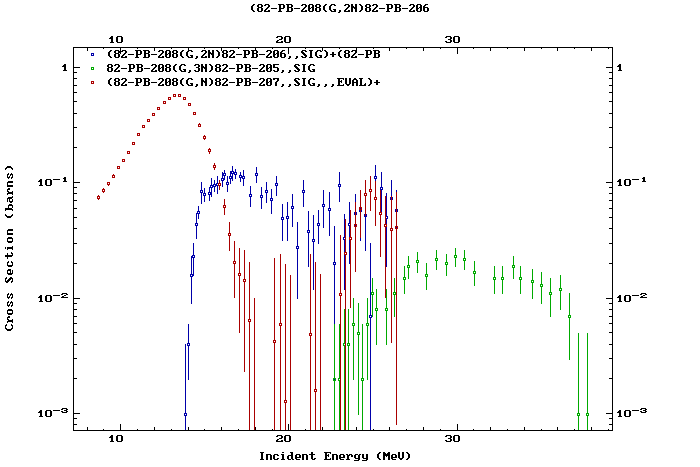- Previous message: Alfredo Ferrari: "RE: USRYIELD binary output"
- Next in thread: Alberto Fasso': "Re: miraculous zero photoneutron production?"
- Reply: Alberto Fasso': "Re: miraculous zero photoneutron production?"
- Maybe reply: Alberto Fasso': "Re: miraculous zero photoneutron production?"
- Messages sorted by: [ date ] [ thread ] [ subject ] [ author ] [ attachment ]
Dear FLUKA friends,
I started monoenergetic photons in homogeneous lead. Simulations were
repeated for different incident energy, ranging from 7.5 to 29.5 MeV. My
USDRAW in mgdraw.f has:
IF (ICODE.EQ.101 .AND. ETRACK.EQ.PBEAM) THEN
J = 0
DO I = 1, Np
IF (Kpart(I)==8) THEN
J = J + 1
END IF
END DO
WRITE (IODRAW) J
END IF
so that only photons at incident energy undergoing inelastic
interactions scores. Slowing down photons were not allowed to score. I
basically mean to count the number of (g,n), (g,2n) and (g,3n) events.
When the count is plotted against the incident energy, I expect
the plot to resemble the photoneutron cross section. Generally results
appear as expected except that at incident energies 21.5, 25.5 and 29.5
MeV, I miraculously get zero counts. Zero counts were obtained at
exactly the same three energies when the simulation was repeated with
carbon and calcium. I can't understand the abrupt zero and the
discontinuity. Could someone please help. Have I missed something?
My results for lead is as follows. Please note the region of interest I
have zoomed into between 21 and 22 MeV. 21.4, 21.49 and 21.6 all
produced non-zero counts while 21.499 and 21.5 produced zero.
MeV (g,0n) (g,n) (g,2n) (g,3n)
7.5 709 1747 0 0
8.5 0 11923 0 0
9.5 0 37225 0 0
10.5 0 85953 0 0
11.5 0 181338 0 0
12.5 0 266842 0 0
13.5 1 328983 0 0
14.5 0 242696 17314 0
15.5 1 90913 76994 0
16.5 0 20916 80017 0
17.5 2 5257 65996 0
18.5 4 1634 52304 0
19.5 8 572 35742 0
20.5 9 235 21941 0
21 13 188 18131 0
21.1 10 190 17868 0
21.2 16 148 17409 0
21.3 10 169 17280 0
21.4 10 155 17156 0
21.49 12 157 17694 0
21.499 0 0 0 0
21.5 0 0 0 0
21.6 12 175 17529 0
21.7 11 158 17700 0
21.8 18 162 18257 1
21.9 13 154 18703 9
22 18 152 19278 18
22.5 20 161 22008 210
23.5 40 168 22886 2608
24.5 32 118 12426 5929
25.5 0 0 0 0
26.5 20 75 2865 9170
27.5 19 94 1715 10760
28.5 32 85 951 9397
29.5 0 0 0 0
Attached inp file, as well as photoneutron cross sections for lead. The
cross section doesn't seem to explain the trend. Calcium, carbon and
lead are unlikely to have absolute-zero valleys at exactly the same 3
energies anyway?
Thanks very much.
mary
*...+....1....+....2....+....3....+....4....+....5....+....6....+....7....+....8
TITLE
Photons in a sea of Lead
GLOBAL -1.0
PHOTONUC 1.0 0.0 0.0 3.0 26.0
BEAM -21.0E-3 1.E4 PHOTON
BEAMPOS 0.0 0.0 0.0
GEOBEGIN COMBNAME
0 0 A simple sea of lead
SPH B1 0.0 0.0 0.0 +500000.0
SPH B2 0.0 0.0 0.0 +500001.0
END
R1 5 +B1
R2 5 -B1 +B2
END
GEOEND
MATERIAL 82 208. 1. 26.0 LEAD
ASSIGNMAT LEAD R1
ASSIGNMAT BLCKHOLE R2
USROCALL
USERDUMP 100 7.0 1.0 dump
RANDOMIZE 1.0 2.0
START 10000000
STOP
